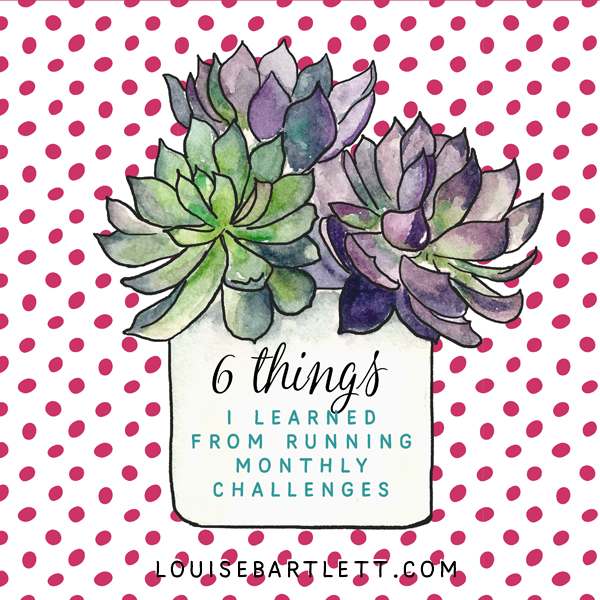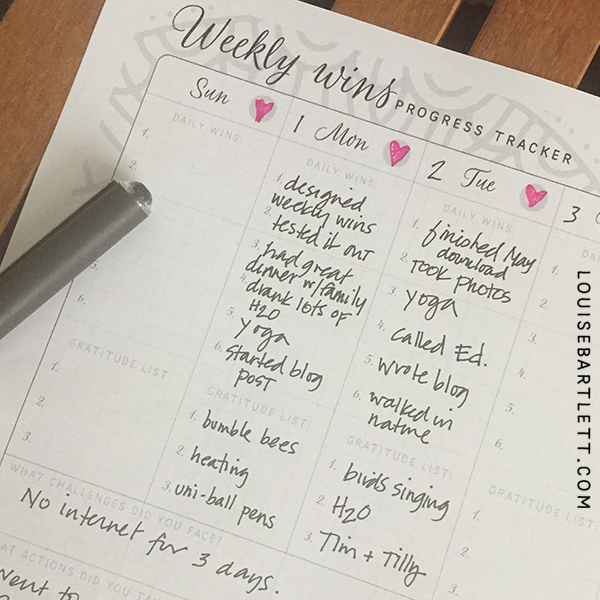6 things I learned from running monthly challenges
In 2017, I decided to set myself and my community a monthly challenge, each month, for a year. Here are six things I've learned and the refinements I’m making for my next six.
My process included:
- reflecting on the challenge at the end of each month
- documenting the successes, challenges and failures
- then, refocusing or refining my delivery for the next challenge
So, what’s the point?
There are many reasons for doing challenges -- mine stem from the idea that challenges keep us creative, keep us motivated and allow us to take action to better our lives in some way. This was especially vital to me during my postpartum (postnatal) depression. It was a way for me to take action daily within a manageable amount of time (5-10 minutes each day) It allowed me to move out of depression and into living a more productive, happy and joyful life. After speaking to my friends, my colleagues and my community, I felt like it was a good idea to set up monthly challenges in a more public way. When I decided to do this, I also decided I’d document the journey. So, here it is so far.
The goals for each challenge
I set about defining a monthly challenge to deliver something inspirational, creatively challenging and valuable to my community. That means delivering high quality, one-of-a-kind content and providing free downloads, such as worksheets, to help them along the way.
Another goal for this year long challenge is to document my progress along the way and deliver some detailed and meaningful findings to help others create their own challenges -- a behind-the-scenes look at how to create a successful challenge. Doing lots of challenges are a great way to get really good at doing challenges, learning from your mistakes and creating better ones for next time. Measure success, make improvements, deliver more value, create more challenges. Repeat.
My first challenge: Minty January
January was a simple 30-day challenge to inspire my community with a colour; minty green. I completed this task with joy and vigour and a pineapple decoration. It was a good one to start with as it only took a few minutes each day to complete. Low commitment. Once deciding upon and focusing on a colour, you’d be amazed at how you start to see it pop up everywhere in your everyday life. It was a successful challenge and I saw a big uptake from quite a few people in my community.
February Love
February was obviously all about love hearts, in all shapes and sizes. Again, not too dissimilar to January’s challenge and also a good way to start to form a positive habit. Also, not a massive investment in time, but an obvious positive effect of noticing and becoming more mindful of our surroundings. And, a good primer for March.
March Mindfulness
This month’s challenge had a new twist - a free calendar download and weekly challenges around the monthly theme of mindfulness. Each week, I sent out a smaller weekly challenge; a breathing exercise, a daily meditation exercise, a gratitude list and noticing things. A little more commitment than the previous month’s challenges, but still easily doable. Behind the scenes, however, required more thought, more design work and generally more time on my part to make it successful. I created and sent out a lovely calendar for people to download, including weekly instructions. This was a great tool to track your progress each week.
Challenge-less April
The simple fact was, I had so much going on in April, that I failed to come up with a challenge and instead found the entire month challenging for myself, which in a way was super successful to me in understanding how much time, effort and planning go into creating and implementing challenges. I became waylaid by househunting which consumed more time than I could have ever imagined. I was admitted to day surgery for a spinal injection for ongoing sciatica. And, just generally trying to hold it all together while caring for a vibrant and fiery 4-year-old. The month was about ACCEPTANCE of wherever you might be right now and it’s all OK. I tried very hard to get a challenge together but realised that sometimes life challenges happen and when they do, one must rise to it. Although there was no challenge, there were plenty of learnings.
Progress and flowers in May
In May, I got back to business with another weekly challenge and a matching download to go with it. With less time being productive and creating challenges for myself and others, May was about creating and sharing my Weekly Wins progress tracker, a tool for setting a weekly intention, tracking daily wins and keeping a daily gratitude list. It’s a simple, yet effective tool for tracking progress and getting into alignment with your true purpose. Read my blog post on Weekly Wins.
Transitional June. Reflect. Refocus. Refine.
So, June is suddenly over, already! Again, no challenge. And even less time spent on social media, sharing and being consistent. As I look back, I can see and track my progress and as I transition into the second half of the year, I can see where I need to refocus some of my energies and how I can continue giving out great content and resources to help others achieve alignment in their lives. June is the month to reflect, refocus and refine.
Six lessons learned
Here are the six things I’ve learned over the past 6 months of running challenges:
- Keep it simple. Simple challenges are the best to start out with. Something that’s going to take less than 5-10 minutes a day to complete will achieve the best results.
- Plan ahead. Weekly challenges are great and easy for your audience to achieve, but they take way more planning to put together, design and promote, so allow enough time to think about the challenge, design, create, iterate and run. It always ends up taking longer than you anticipate. Always.
- Challenge from experience. The best challenges are the ones you’ve actually done yourself, so you can anticipate the ups and downs of the challenge, where endurance might dip and where motivation is needed.
- Stay connected. There must be consistency throughout the challenge. If it’s a 30-day challenge, then you need to be active in the challenge for 30 days. Ask people how they are doing, what they need support with and how you can help. And, offer a reward at the end of it -- it could be anything, cash or product prize, a free coaching session or even a mention in your feed or newsletter can go a long way to making your community feel included and valued.
- Feedback is a gift. The only way to become better at creating successful challenges is by asking for feedback. At the end of a challenge, ask your community what they liked (or didn’t) about your challenge. Use this information to improve it for next time. The only way to create content that your community really really loves is by listening to them and incorporating their feedback into your content. When you’ve listened to others, you’ll have a first class product, service or challenge!
- Learn the lesson. Take the time at the end of each challenge to look back and see how it went. Celebrate the successes and embrace the challenges or shortcomings. Combine this with your community feedback and you have a winning combination to be better prepared for next time. If you’re not being mindful of the process and document how you felt under certain pressures, you’ll keep repeating the same mistakes.
So, what do the next 6 months hold for challenges? Some refocus and refinement and a continuous testing ground for creating and running challenges, and refining them to help others inject more happiness, productivity and creativity into their lives.
July starts in just a few days and a new challenge begins! I hope you’ll consider joining in and taking action!
Please let me know if you’ve created any successful (or not) challenges. Do you have any other tips to share? Please post in the comments below and I’ll update the post to include any ideas I haven’t covered. My aim is to provide great tips so others can create successful challenges and use this research to avoid the pitfalls that we’ve all faced when posting a challenge.





